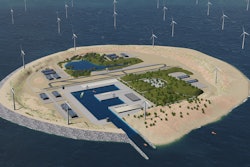W
h
it
e
pa
pe
r
Why ERP fails at
EntERPRisE PRojEct
ManagEMEnt
contEnt
study REsults .......................................................................................................... 2
Risk, cash PooRly ManagEd ................................................................................... 5
conclusion .............................................................................................................. 6
about ifs ................................................................................................................. 8
1Why ERP fails at EntERPRisE PRojEct ManagEMEnt
Why ERP fails at EntERPRisE
PRojEct ManagEMEnt
By Mike LorBiecki
Vice President of saLes
ifs north aMerica
When it comes to specific needs to be satisfied by enterprise software such as enter-
prise resource planning (ERP), not every company is created equal. A manufacturer
with predictable, repetitive processes may find a broad spectrum of software offerings
that can meet their needs. But some companies, like engineer-to-order manufacturers,
engineering procurement and construction contractors, and even process manufac-
turers find their situation so demanding than even tier one ERP products cannot
meet their needs completely.
One area that frequently is left wanting is project management. Because ERP came
from the world of materials planning for repetitive manufacturing, these applications
cannot address the more anecdotal, complex, and dynamic requirements of real-time
enterprise project management.
At least that is generally the sentiment we at IFS North America encounter in our
interactions with executives at project-centric companies. And that is also the con-
clusion of a recent study IFS North America conducted with help from Mint Jutras
Principal Analyst Cindy Jutras.
Among the study’s key findings:
• While the use of set projects to manage tasks and procedures is a necessity for
85 percent of study respondents, 39 percent have no integration between their
project management software and their ERP or other enterprise system.
• The ability to control processes in real time correlates directly with better inte-
gration between project management functionality and ERP. The best results
stem from running an ERP application with embedded project management
functionality, which is a rarity.
• Risk management is one of the major gaps left by existing ERP solutions used
by project-intensive companies. This ought to concern company stakeholders
and owners as they are exposed to financial risk as well as potential legal
repercussions they cannot predict or mitigate.
2Why ERP fails at EntERPRisE PRojEct ManagEMEnt
study REsults
In September 2012, IFS North America conducted a study among manufacturing
executives and professionals of middle- to large-market manufacturers to better
understand how well current ERP options meet the needs of companies in project-
driven industries including engineer-to-order manufacturing, aerospace and defense
manufacturing. engineering, procurement, and construction contracting, and asset-
intensive businesses such as batch process manufacturing.
We surveyed more than 200 executives with industrial companies having more
than $100 million in annual revenue. We then ran frequencies on the data to identify
the companies with more complex, project-centric business models. This included
companies engaged in engineer-to-order manufacturing, companies delivering
projects as an engineering, procurement, and construction contractor, and those
involved in batch processing, and thus the enterprise asset management of process
manufacturing plants and equipment.
It becomes clear, reviewing the data, that exposure to projects enters an organi-
zation in two different ways. Either the company relies on projects as part of its
product delivery system, or it relies on projects as a way to manage its capital assets.
Engineer-to-order manufacturers and engineering procurement construction
contractors are examples of the former. They are involved in short-run or one-off
projects where the administrative and management overhead costs normally counted
as overhead must be accounted for and managed just as aggressively as materials and
manufacturing or fabrication costs. Process manufacturers are an example of the lat-
ter. They plan, construct, and then maintain process manufacturing plants and
equipment to yield a return over a period of years or decades. That entire asset life-
cycle may be considered as a project that needs to be managed on a macro level.
But on a micro level, there are numerous equipment installations, refits, overhauls,
and plant shutdowns that require aggressive project management to control cost,
ensure a successful outcome, and limit business disruption.
Many other manufacturers, according to the study, find that their product life-
cycles are short enough that they, too, are best managed as projects would be. The
conception, engineering, design, prototyping, and product launch cycle may come
frequently enough that they represent a significant portion of the cost of a given
product or product line. Again, for these manufacturers, project management is
required at both the macro and micro levels.
3Why ERP fails at EntERPRisE PRojEct ManagEMEnt
Very few executives in this study reported having substantial integration between project management functionality and
their underlying enterprise application.
Another fascinating revelation coming out of the IFS study was the direct relation-
ship between the degree of integration among project management tools and the
underlying enterprise system. Without exception, important project elements are
better controlled when there is tight integration between systems used to manage
both the projects and the rest of the enterprise. It is not hard to imagine why this is
the case. If a company is using a stand-alone piece of project management software,
that system may have quite limited functionality, such as really only being a way to
display project data visually across a Gantt chart, or more proactively track project
deliverables. But if the system for managing projects is removed from the enterprise
system that actually drives the completion of that work and the reporting of project
results across functions like purchasing, maintenance, engineering, and manufacturing
or fabrication, real-time visibility and control is hampered.
The fact that 39 percent of respondents had no integration between their project
management and ERP systems and only 4 percent use a module of their ERP as part
of their project management solution would suggest that there is a great deal of room
for improvement when it comes to the use of enterprise project control. If anything,
the fact that just 4 percent of respondents overall reported using a module of their
enterprise application for project management seems quite high given what we know
about the project management functionality available from major enterprise software
vendors!
Whether an enterprise handles projects through a fully integrated suite or a separate
order administration or manufacturing system of record, there must necessarily be
at least some integration with project management functionality to avoid work being
performed on outdated revisions, duplicate data entry, schedule slip, and unpleasant
surprises that can threaten profitability.
4Why ERP fails at EntERPRisE PRojEct ManagEMEnt
The length of projects a company is involved with naturally contributes to the prob-
lems they may experience trying to run separate project management and enterprise
software. The longer the duration of the project, the more complex it likely is and
the greater the need for integration with things such as advance ordering of long-lead
time items, subcontractor billing and subcontract management, progress billing, and
cash flow management. In some cases, projects run by study participants are fairly
well contained at less than a month long. However, most engineer-to-order environ-
ment respondents are involved in projects of between one and six months.
the high percentage of engineer-to-order manufacturers reporting that they do not use a project management system
was surprising. how are they successfully managing months-long projects without one?
Despite this involvement in months-long projects, engineer-to-order manufacturers
seem to still mainly be using desktop applications to manage projects, which really
drives a wedge between project planning and critical management functions like
finance, manufacturing or fabrication, customer relationship management, etc. This
can fragment data by pulling it out of the shared enterprise environment.
Use of Microsoft Project to manage projects is prevalent among study respondents.
There is an enterprise-level version, but the vast majority of Microsoft Project use is
in a desktop configuration. Microsoft Excel, the universal spreadsheet management
tool, is also heavily used (see the earlier IFS study, Does ERP Mean EXCEL Runs
Production?). The key to using Excel without creating silos or islands of data is to
integrate it with enterprise applications so the enterprise data can be shared through
Excel while it still resides in the ERP system. Once an Excel spreadsheet exists wholly
outside of the enterprise software environment, managers are at risk of making
decisions based on bad data, or the enterprise application may cease to be the true
system of record.
5Why ERP fails at EntERPRisE PRojEct ManagEMEnt
Risk, cash PooRly ManagEd
Projects involve risk—more risk than repetitive processes that are more predictable
and easily controlled. And while risk management may be intuitively associated
with assuring on-time and under-budget project performance, in many companies
and industries it also has implications for performance against contractual commit-
ments as well as protection of the environment and mitigation of safety risks, factors
not often managed in stand-alone project management software systems.
Study results also show that areas of risk apart from budget and timeline are less
effectively controlled in enterprise software than concrete factors like cash,
machines, and materials are. While 78 percent of respondents can control schedules
in real time and 76 percent can control costs, a much smaller percentage can manage
risk in real time.
risk management and cash management are the biggest gaps in existing erP solutions. even with full or embedded
integration between projects and erP systems, only around half of respondents can control these two variables.
Among respondents reporting full integration or embedded project control within
their ERP system, the ability to control the cost and schedules increases into the
high 80th or even the 90th percentile. With this tighter integration, the ability to
manage materials, human resources, machinery, cash, and risk is held by half to
two-thirds of respondents. But risk management is the least supported project need,
even with full integration between project management systems and existing ERP
systems.
It is also not surprising that cash management is poorly handled by existing
project ERP configurations. To manage cash in real time in a project environment
requires very thorough integration indeed, as contract management, purchasing, and
other functionality plays a role in determining committed cost, the degree to which
firm obligations or purchases have been made with regard to project expenditures.
Very few applications can track committed cost.
6Why ERP fails at EntERPRisE PRojEct ManagEMEnt
conclusion
The data from the IFS study ought to be of interest to the management of any
company that relies on projects as a core business discipline. And since more and
more manufacturers are either already performing projects or plan to expand into
manufacturing modes that rely on projects rather than repetitive make-to-stock
(see earlier IFS study), the project-focused organizations make up a broad swath of
the industrial sector.
Years ago, analysts and software vendors, including IFS, created a new category of
enterprise software called project-based solutions (PBS). These applications originate
not so much from the world of materials requirement planning (MRP) in the auto-
motive industry, but from project-oriented industries involving capital projects.
In an enterprise selection cycle, a company ought to ask the vendor hard questions
regarding the degree of project functionality built directly into the application
functionality and the degree to which this functionality relies on integration between
a stand-alone project management tool and the enterprise application. As the data in
this study attests, companies running ERP systems with built-in project management
functionality can expect more favorable results and a higher degree of control than
those who are running these functions on separate and distinct pieces of software.
Mike Lorbiecki is Vice President of sales at ifs north america, itasca, ill. he has held sales
management positions with the company since 2000, and holds a degree in finance from the
University of st. thomas in st. Paul, Minn. download a copy of this study on ifs’ web site, here.
7Why ERP fails at EntERPRisE PRojEct ManagEMEnt
en
48
27
-1
P
ro
du
ct
io
n:
if
s
co
rp
or
at
e
M
ar
ke
tin
g,
f
eb
ru
ar
y
20
13
.
about ifs
ifs is a public company (oMX sto: ifs) founded in 1983 that develops,
supplies, and implements ifs applications™, a component-based
extended erP suite built on soa technology. ifs focuses on agile
businesses where any of four core processes are strategic: service
& asset management, manufacturing, supply chain and projects.
the company has more than 2,000 customers and is represented
in some 60 countries with 2,800 employees in total.
More details can be found at www.ifsWoRld.com.
for further information, e-mail to
[email protected]
www.ifsWoRld.com
this docUMent May contain stateMents of PossiBLe fUtUre fUnctionaLit y for ifs’ software ProdUcts
and technoLogy. sUch stateMent s of fUtUre fUnctionaLit y are for inforMation PUrP oses onLy
and shoULd not Be interPre ted a s an y c oMMitMent or rePresentat ion. ifs and aLL ifs ProdUct
naMes are tr adeMarks of ifs . the naMes of actUaL c oMPanies and ProdUct s Mentioned herein
May Be the tr adeMarks of their resPect iVe owners.
ifs aB ©2013
aMERicas. . . . . . . . . . . . . . . . . . . . . . . . . . . . . . . . . . . . . . . . . . . . . . . . . . . . . . . . . . . . . . . . . . +1 888 437 4968
argentina, BraziL, canada, MeXico, United states
asia Pacific . . . . . . . . . . . . . . . . . . . . . . . . . . . . . . . . . . . . . . . . . . . . . . . . . . . . . . . . . . . . . . +65 63 33 33 00
aUstraLia, indonesia, JaPan, MaLaysia, new zeaLand, PhiLiPPines,
Pr china, singaPore, thaiLand
EuRoPE East and cEntRal asia . . . . . . . . . . . . . . . . . . . . . . . . . . . . . . . . . . . . . +48 22 577 45 00
BaLkans, czech rePUBLic, georgia, hUngary, israeL, kazakhstan,
PoLand, rUssia and cis, sLoVakia, tUrkey, Ukraine
EuRoPE cEntRal . . . . . . . . . . . . . . . . . . . . . . . . . . . . . . . . . . . . . . . . . . . . . . . . . . . . . . . . . +49 9131 77 340
aUstria, BeLgiUM, gerMany, itaLy, netherLands, switzerLand
EuRoPE WEst . . . . . . . . . . . . . . . . . . . . . . . . . . . . . . . . . . . . . . . . . . . . . . . . . . . . . . . . . . . +44 1494 428 900
france, ireLand, PortUgaL, sPain, United kingdoM
MiddlE East and afRica . . . . . . . . . . . . . . . . . . . . . . . . . . . . . . . . . . . . . . . . . . . . . . . .+971 4390 0888
india, soUth africa, sri Lanka, United araB eMirates
noRdic . . . . . . . . . . . . . . . . . . . . . . . . . . . . . . . . . . . . . . . . . . . . . . . . . . . . . . . . . . . . . . . . . . . . .+46 13 460 4000
denMark, norway, sweden
finland and thE baltic aREa. . . . . . . . . . . . . . . . . . . . . . . . . . . . . . . . . . . . . . . +358 102 17 9300
estonia, finLand, LatVia, LithUania
























